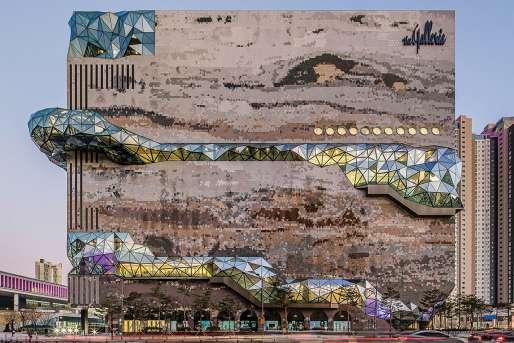
2 minute read
The Galleria @ Gwanggyo, South
(Source: Hong Sung Jun, courtesy of OMA)
THE GALLERIA @ Gwanggyo, South Korea
Advertisement
Dutch architecture studio OMA has recently store has been designed to be a landmark for the area’s housing completed the Galleria department store in district. Gwanggyo, South Korea. The store is the sixth “The first time we came to Gwanggyo the entire city felt as one branch of Galleria, Korea’s first and largest big temporary condition, missing any sense of permanence. That is upscale department store franchise founded in why we conceived the project as a point of gravity for Gwanggyo the 1970s, and has remained at the forefront of – in the shape of a stone cube, as if it was the origin of the city,” the premium retail market in the country since. explained OMA partner Chris van Duijn. Located at the center of this young urban development The cube-shaped building is clad in tessellated triangles of surrounded by tall residential towers, the Galleria department stone. The mix of beige, brown and earthy colours is designed
(Source: Hong Sung Jun, courtesy of OMA)


(Source: Hong Sung Jun, courtesy of OMA) (Source: Hong Sung Jun, courtesy of OMA)


(Source: Hong Sung Jun, courtesy of OMA)

to make the building appear like a slab of rock or a cross-section of earth. Breaking up the geometric shape of the 10-storey department store is a multifaceted-glass passage, which is wrapped around the building, projecting from the facade.
“On every level there is a relationship among the loop, the central space and the surrounding shops. The route is sometimes excavated from the building, eating its way through the stone, and other times the glass openly exits the façade, creating a steel structure of regular triangular grids,” said Van Duijn.
Van Duijn also explained that the glass-enclosed passage starts at ground level and passes twice around the building, providing access to each floor and finally the roof terrace.
“The building includes other, more public oriented programme than retail, including a culture centre and a roof garden at the top levels of the buildings. So the loop should attract people to take the long route (540m) from the sidewalk up to the roof and stimulate other activities to occur than only retail,” he continued.
A food market and deli are located in the building’s basement, with eight retail floors above it. Along with stairs and lifts all of the floors are connected by the glass external loop. The department store’s upper floors, which are also access for the passageway, contain leisure facilities. The eighth floor contains bars and restaurants while the ninth and tenth a multi-screen cinema and the eleventh a space described as the “lounge and academy”.
“Through collaboration with world-class architect OMA, it is well received both domestically and internationally for its creative architecture that is distinct from typical department store format,” said Hanwha Galleria president and CEO Eun Soo Kim.
“Galleria Gwanggyo is the most beautiful department store and is expected to become a unique landmark representing Korea and the world, providing a new inspiration to customers.”










